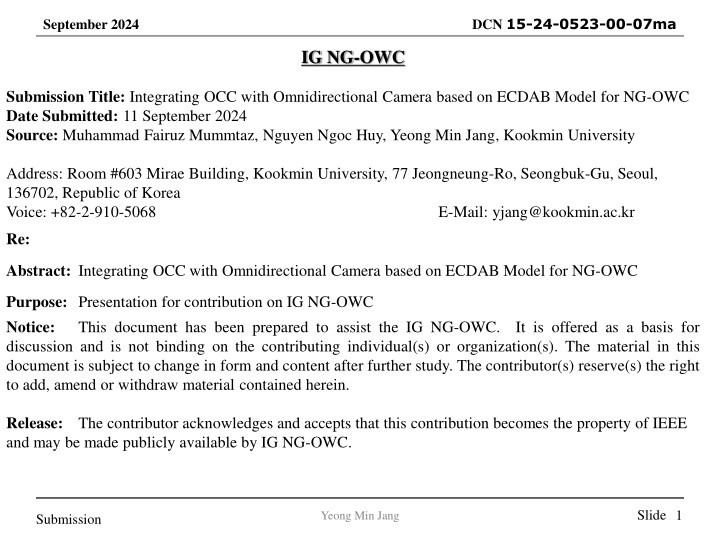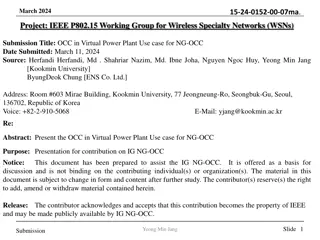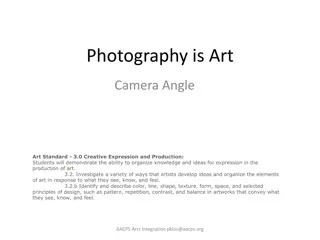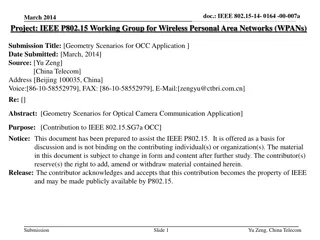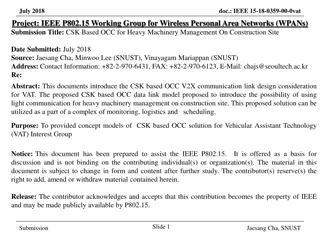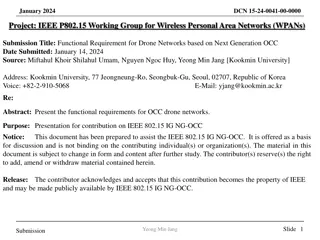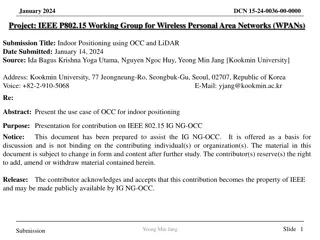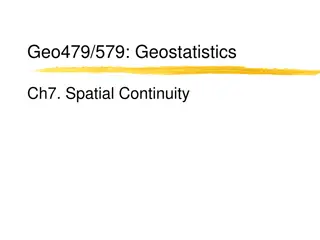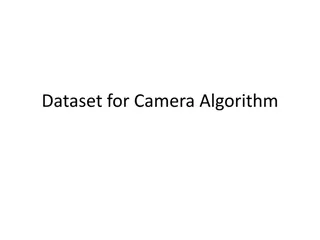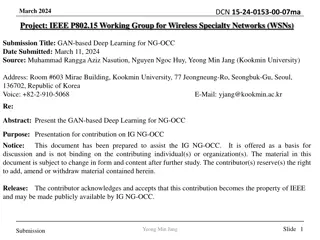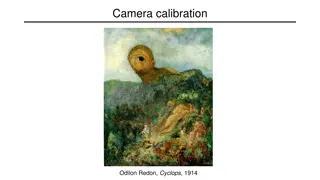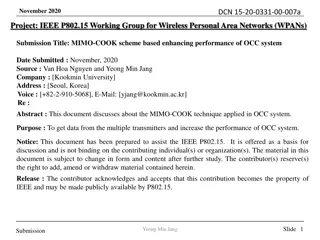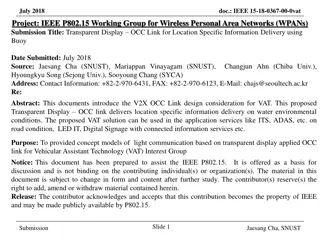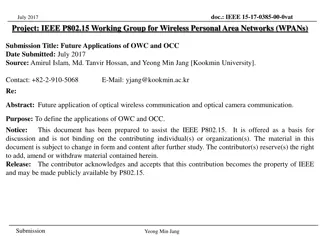Integrating OCC with Omnidirectional Camera based on ECDAB Model
In this submission, the integration of Optical Camera Communication with an Omnidirectional Camera using the ECDAB model is explored. The ECDAB model works to prevent image distortion in 360-degree capturing, enhancing data quality and transmission reliability. Learn about the challenges, solutions, and benefits of this innovative approach.
Uploaded on Mar 09, 2025 | 0 Views
Download Presentation

Please find below an Image/Link to download the presentation.
The content on the website is provided AS IS for your information and personal use only. It may not be sold, licensed, or shared on other websites without obtaining consent from the author.If you encounter any issues during the download, it is possible that the publisher has removed the file from their server.
You are allowed to download the files provided on this website for personal or commercial use, subject to the condition that they are used lawfully. All files are the property of their respective owners.
The content on the website is provided AS IS for your information and personal use only. It may not be sold, licensed, or shared on other websites without obtaining consent from the author.
E N D
Presentation Transcript
DCN 15-24-0523-00-07ma September 2024 IG NG-OWC Submission Title: Integrating OCC with Omnidirectional Camera based on ECDAB Model for NG-OWC Date Submitted: 11 September 2024 Source: Muhammad Fairuz Mummtaz, Nguyen Ngoc Huy, Yeong Min Jang, Kookmin University Address: Room #603 Mirae Building, Kookmin University, 77 Jeongneung-Ro, Seongbuk-Gu, Seoul, 136702, Republic of Korea Voice: +82-2-910-5068 E-Mail: yjang@kookmin.ac.kr Re: Abstract: Integrating OCC with Omnidirectional Camera based on ECDAB Model for NG-OWC Purpose: Presentation for contribution on IG NG-OWC Notice: This document has been prepared to assist the IG NG-OWC. It is offered as a basis for discussion and is not binding on the contributing individual(s) or organization(s). The material in this document is subject to change in form and content after further study. The contributor(s) reserve(s) the right to add, amend or withdraw material contained herein. Release: The contributor acknowledges and accepts that this contribution becomes the property of IEEE and may be made publicly available by IG NG-OWC. Slide 1 Yeong Min Jang Submission
DCN 15-24-0523-00-07ma September 2024 Integrating OCC with Omnidirectional Camera based on ECDAB Model for NG-OWC September, 2024 Slide 2 Yeong Min Jang Submission
DCN 15-24-0523-00-07ma September 2024 Contents Background How ECDAB (Edge Continuity Distortion-Aware Block) Model works Integrating OCC with Omnidirectional Camera based on ECDAB Model Conclusion Slide 3 Yeong Min Jang Submission
DCN 15-24-0523-00-07ma September 2024 Background In OCC, the camera as a Rx captures images/video streams of the intensity modulated light sources (a single LED, multiple LEDs and digital display screens) as a Tx and extracts the information by means of image processing. But to get the proper quality data we need to align the transmitter inside of the receiver (camera) point of view which has some challenges for real-world implementation [1]. A 360 camera (omnidirectional camera) can be a solution as it is captures a 360-degree field of view, allowing it to capture everything around itself (front, behind, above, and below the camera) with format of sphere- shape-image as an output of the camera. However, using 360 omnidirectional images which are usually processed into plane images by equirectangular projection (ERP) that will generates discontinuities at the edges and can result in serious distortion within the images. Therefore, edge continuity distortion-aware block (ECDAB) for 360 omnidirectional images used to prevents the discontinuity of edges and distortion by recombining and segmenting features. ECDAB is a machine learning model which will extracts continuous features through recombination features and group convolution is performed through segmentation features using distinct convolution kernels between different blocks to alleviate distortion [2]. Slide 4 Yeong Min Jang Submission
DCN 15-24-0523-00-07ma September 2024 How ECDAB (Edge Continuity Distortion- Aware Block) Works ECDAB model process the ERP images within 2 steps, firstly the continuous edge features of ERP images are extracted through the edge continuity aware block (ECAB). The processed results are then sent to the distortion-aware block (DAB) to alleviate the influence of image distortion [2]. In ECAB model, the image is divided into three pieces then the right and left pieces are flipped horizontally and stitched together. After that, the stitched image will be stacked together with the middle piece of the picture to extract its features using grouping convolution. Slide 5 Yeong Min Jang Submission
DCN 15-24-0523-00-07ma September 2024 How ECDAB (Edge Continuity Distortion- Aware Block) Works The result of grouping convolution (feature extracted images) are also once again segmented into 2 pieces and flipped horizontally. After that, all the result from grouping convolution process are stitched together to form features as the input shape. Finally, a convolution operation is performed to mitigate the negative effects of folding. So, the left and right edges of features extracted by ECAB contain continuous information. To further alleviate the influence of distortion, features extracted by ECAB are sent to the distortion-aware block (DAB) for further processing. Slide 6 Yeong Min Jang Submission
DCN 15-24-0523-00-07ma September 2024 How ECDAB (Edge Continuity Distortion- Aware Block) Works The distortion of ERP images is related to the latitude of the 360 omnidirectional images, while the distortion of the 360 omnidirectional images after ERP is related to the height [2]. So, in the DAB, the ERP image is divided into N blocks along the row direction, and then these blocks are stacked on the several channel dimension. Then the segmented images are grouped for the convolution operation. Finally, the results obtained by grouping convolution are readjusted to the original shape and then a convolution operation is carried out to compensate for the influence of segmentation. Slide 7 Yeong Min Jang Submission
DCN 15-24-0523-00-07ma September 2024 Integrating OCC with Omnidirectional Camera based on ECDAB Model 1 0 1 0 0 1 1 0 0 Segmentation Few-shot Algorithm Extract Data Example of Omnidirectional Camera Image Output Implementing omnidirectional camera can enable OCC systems to capture light signal from every possible directions. Ideal for environments where the receiver might not be perfectly aligned with the transmitter. Integrating 360 camera in OCC systems for aerial application will be particularly useful because there is a necessity for capturing the 360 point of view frame to perform the OCC communication properly. Slide 8 Yeong Min Jang Submission
DCN 15-24-0523-00-07ma September 2024 Conclusion Implementing 360 camera as a receiver for OCC system significantly enhances the flexibility of OCC systems by enabling them to capture light signal from every possible directions. By enabling the system to capture the whole frame of scene will erase the need for another system to detect the transmitter, reduce computational requirement for OCC systems and cost-effective to implement. By using multiple transmitters and receive the data with 360 camera, OCC can achieve higher data rates and more reliable communication. This is particularly useful in complex environments like smart cities, indoor navigation or drone navigation. By applying ECDAB (Edge Continuity Distortion-Aware Block) to the system, it will reduce the distortion problem within the ERP image produced by 360 camera. So, the collected transmission data within the image can be extracted properly. Slide 9 Yeong Min Jang Submission
DCN 15-24-0523-00-07ma September 2024 Reference 1. Cahyadi, W.A.; Chung, Y.H.; Ghassemlooy, Z.; Hassan, N.B. Optical Camera Communications: Principles, Modulations, Potential and Challenges. Electronics 2020, 9, 1339. 2. Zhang X, Yang D, Song T, Ye Y, Zhou J, Song Y. Classification and Object Detection of 360 Omnidirectional Images Based on Continuity-Distortion Processing and Attention Mechanism. Applied Sciences. 2022; 12(23):12398. 3. Lavrenko T, Ahmed A, Prokopenko V, Walter T, Mantz H , Turbulence-resistant high-capacity free-space optical communications using OAM mode group multiplexing, Opt. Express, vol. 31, no. 9, p. 14454, 2023. Slide10 Yeong Min Jang Submission
